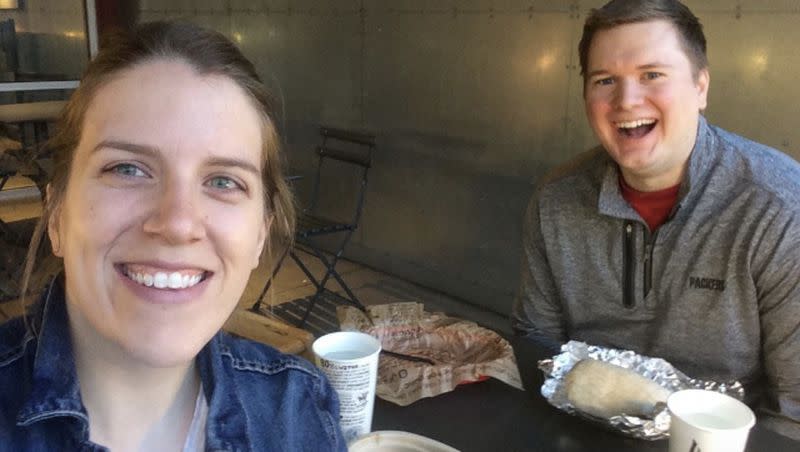How self-created rituals can change your life

This article was first published in the State of Faith newsletter. Sign up to receive the newsletter in your inbox each Monday night.
One of my favorite things about my relationship with my husband is the quirky rituals we’ve created to commemorate special moments in our lives and celebrate exciting new developments.
For example, each April 19, which is the anniversary of our first date, we have Chipotle for dinner, since that’s where we met in person for the first time.
And each year when the Green Bay Packers finish their final game of the season, we run to the nearest store and buy a bunch of desserts, then try to drown our sorrows in chocolate.
I’ve always thought of these rituals and others as an excuse to spoil ourselves rather than as something spiritual or otherwise significant. But a recent column in The New York Times taught me to take my self-developed rituals more seriously and acknowledge their important role in my life.
“Rituals can be religious or secular; they can range from traditional to offbeat. But even the small ones add richness to our lives,” wrote Jancee Dunn in the column.
Dunn went on to explain, with the help of experts on rituals, that even goofy rituals can deepen our relationships with loved ones and bring meaning to chaotic moments. They improve our quality of life, whether they’re extravagant or short and sweet.
Here are my favorite rituals highlighted in the New York Times piece:
“Happy Meatloaf to You”: Michael Norton, author of a forthcoming book on rituals, told Dunn that his family sings “Happy Meatloaf to You” to the tune of “Happy Birthday to You” each time they have meatloaf for dinner. The ritual started as a way to convince his daughter to embrace the dish.
“Welcome Home Enchiladas”: Dunn explained that she and her husband always have homemade enchiladas for dinner when one of them returns from a trip. “We can’t remember how it started (or why they must be chicken and green chile). But I look forward to them every time I go away,” she wrote.
A “house cooling” party: Dunn discovered the concept of a house cooling party on Instagram. It’s a celebration held just before you move out of a beloved home. You invite people over to share their favorite memories from time spent in the space. House warming parties are common, so why can’t house cooling parties be, too?
Fresh off the press
5 years after a Supreme Court win, Christian baker Jack Phillips’ fight is far from over
What Matthew Perry said about prayer and religion
Temples, tailgates and an unforgettable road trip
Dave Ramsey textbook can be used in public schools despite Bible verses, lawyer says
Term of the week: Labyrinth
If you’re in your 30s or 40s, the word labyrinth likely calls to mind a movie of the same name featuring David Bowie. But in the religious context, a labyrinth is a path to walk while praying that can be a permanent feature of a churchyard or a temporary addition to a sanctuary. (The labyrinths I’ve walked before were printed on large pieces of canvas that could be spread out like a rug.)
Christians have used labyrinths since the Middle Ages, according to the McGrath Institute for Church Life at the University of Notre Dame. “The most famous example of a Christian labyrinth intended for prayer is the stone labyrinth inlaid on the floor of the Chartres Cathedral in France,” the Institute reports.
What I’m reading ...
Six years after protests over the removal of a Robert E. Lee statue in Charlottesville, Virginia, turned violent, the removed statue has been melted down, according to Religion News Service. The bronze will be turned into a new, yet-to-be-designed art project.
The Amish champion values like peace and modesty, but you wouldn’t necessarily conclude that from visiting “Amish-style” gift shops in Ohio. Susan Trollinger, an English professor at the University of Dayton, recently explained in a piece for The Conversation that gift shop wares, including signs celebrating gun ownership and coffee mugs advertising gun calibers, capitalize on romanticism about Amish culture without representing what the Amish are all about.
I took the day off Thursday to spend time with my mom and see “Killers of the Flower Moon.” I left the theater with many, many questions and was delighted to find the answer to “How did the Osage Nation become Catholic?” in a story from America magazine.
Odds and ends
Take this candy-themed quiz from The New York Times as you continue eating Halloween candy. I answered seven questions correctly. Can you beat me?
I watched “Saturday Night Live” for the first time in a long time over the weekend and really enjoyed host Nate Bargatze’s opening monologue. Plus, there was a very unexpected (and very funny) biblical reference in a skit about Halloween costume ideas.

